ESTE DÍA ese AÑO
Prof. G. Venkataraman
Amar a Sai Ram y saludos desde Prashanti Nilayam. Hoy es Sri Sathya Sai Día Aradhana. Inevitablemente, mi pensamiento se dirige de nuevo a esta misma fecha, pero hace cuatro años, como debe ser el caso de la mayoría de ustedes.
Los recuerdos traumáticos de abril 2011
Fue alrededor de las 7:30 de la mañana del 24 de abril de 2011, recibí una llamada telefónica de un buen amigo mío que estaba en el hospital. Con una voz frenética siguió susurrando, "condición de Swami es muy grave, muy grave." Luego cortó la llamada.Francamente, esto fue una noticia que no esperaba y hay una razón por la que voy a venir a la brevedad. Pero para seguir adelante con los acontecimientos de la mañana, alrededor de 7:50 de la mañana, recibí una llamada, una vez más desde el Hospital. Esta vez fue el Sr. Giri en la línea que con gravedad, dijo, "Sai Ram Sir. Lo siento mucho informarle de que nuestro amado Swami falleció un par de minutos atrás. Sr. Chakravarthi está de pie junto a mí, y él quiere decir algo. "
Un momento después, el Sr. Chakravarthi puso al teléfono y le dijo: "Doc - que era la forma en que siempre se dirigió a mí - doc, por favor prepare una nota necrológica." Le pregunté en qué estilo debería ser. Puesto que él no estaba preparado para esa pregunta, me corté y le dije: "¿Quieres que se haga como lo que aparece en decir The Times de Londres? "" Sí ", el Sr. Chakravarthi regresó, y añadió," que podría ser alrededor 300 palabras. Queremos liberar a la prensa ". Inmediatamente me puse a trabajar. El cuerpo funcionaba como una máquina, mientras que la mente estaba en otra parte, pretender que lo que había ocurrido era un sueño; en cualquier caso, era una especie de adormecer a sentir ningún dolor.
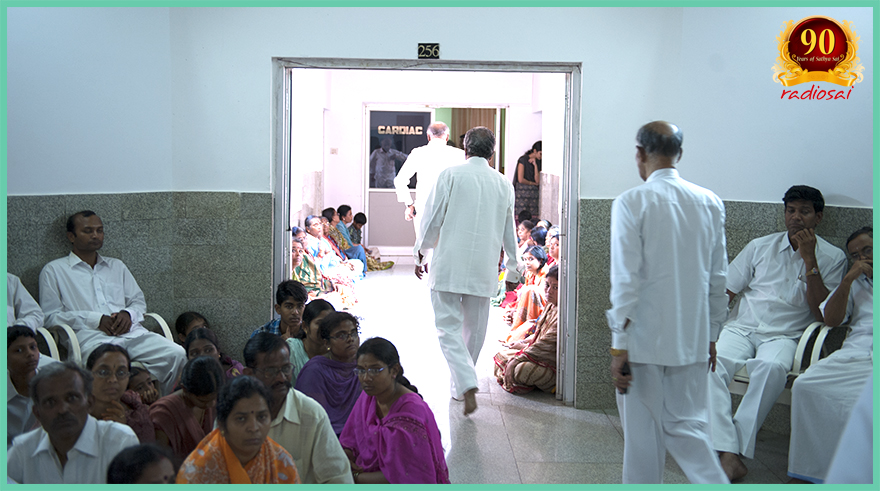 |
Inevitablemente mi mente se fue a los acontecimientos de la noche anterior. Como era nuestra rutina diaria, el profesor Pandit y me fui directamente a la oficina del Dr. Safaya. Para aquellos que no saben, el Prof. Vishwanath Pandit es un distinguido economista, quien ha enseñado en el Instituto de Swami desde 1985, y también sirvió como el octavo vicerrector. Volviendo a lo que estaba diciendo, el Dr. Safaya fue director, cargo que tenía en la mano desde antes de la inauguración del hospital el 22 de noviembre de 1991. Al igual que el profesor Pandit, el Dr. Safaya también era originario de Cachemira, y eran viejos amigos. En el momento que nos fuimos, el Dr. Safaya estaba finalizando el boletín médico diario para el lanzamiento a la prensa. Todos los días antes de salir, el Dr. Safaya invariablemente darme una copia del Boletín Médico de ese día en Swami, para su utilización por Radio Sai. En el medio, la discusión sería siempre por la salud de Swami y su condición en ese momento en particular.
Recuerdo que unos dos días más o menos después de que fue admitido, Swami requieren la inserción de lo que se llama una bomba de balón que hizo el trabajo del corazón de bombear mucho más fácil. Se trataba de 19:00 de ese día, y una hora antes, dos médicos que habían volado especialmente desde Bangalore en helicóptero izquierda, hace su trabajo. Gracias al Dr. Safaya, tanto el profesor Pandit y yo éramos capaces de echar un vistazo rápido de Swami como Él fue llevado adentro en una cama especial movible en la UCI especial significado para él. Dr. Safaya entró junto con Swami y los médicos, mientras que el profesor Pandit y yo nos sentamos en las sillas colocadas fuera para la gente como nosotros.
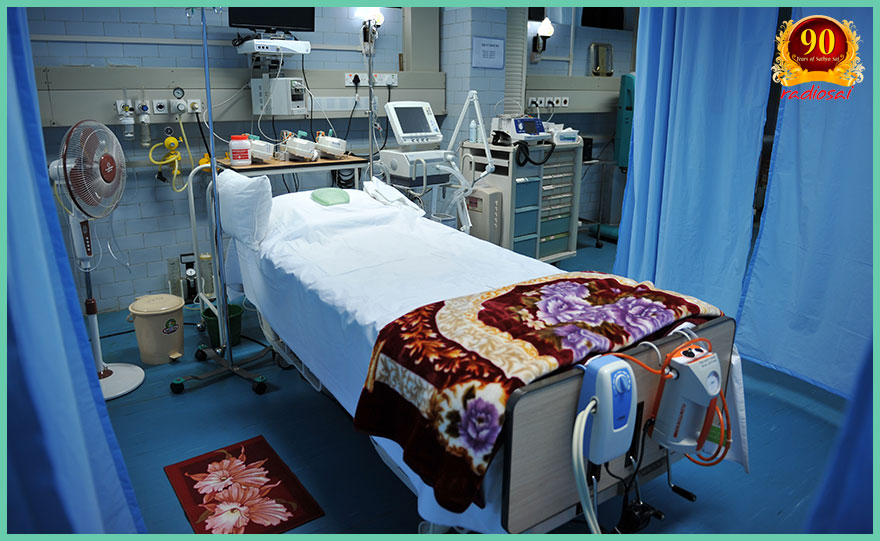 |
Entonces le dije al Dr. Safaya, " Doctorsaab , usted puede recordar que un Comité de alta potencia tiene previsto visitar el Hospital de conversaciones con usted y algunos de los científicos del Instituto de Swami, en relación con un proyecto de instrumentación médica.Esa visita se debe el 6 de abril, que no está muy lejos. Teniendo en cuenta que Swami está en el hospital, tal vez deberíamos pedir al Comité que aplazar su visita por el momento. ¿Qué dices? "Mirando muy confiado, el Dr. Safaya respondió:" No te preocupes. Swami iba a estar bien y, de hecho, me acogerá un almuerzo para el Comité ".
Lamentablemente, eso no iba a ser ya que la salud de Swami se negó a ser mejor; por otra parte, que entró en un declive lento debido a fallo multiorgánico. Unos quince días más o menos después de la admisión cuando estaba en la oficina del Dr. Safaya, junto con el profesor Pandit, por supuesto, le pregunté, " Doctorsaab , este fracaso multiorgánico - para cuántos días hace que dure "Antes Dr. Safaya podía respuesta, alguien que estaba en la sala a tope en decir, "voy a responder a esa pregunta porque yo enterado sobre el fracaso multiorgánico. Le pasó a mi hija-en-ley, y tardó sólo cinco días. "Entonces le dije," Parece que Swami está estirando deliberadamente esto para probarnos. Al final, estoy seguro de que sería recuperarse dejando a todos atónitos! "
Menciono todo esto porque quiero volver a la noche antes de Mahasamadhi, es decir, 23 de abril de 2011. Poco después de que entramos en la habitación del director y pedimos la pregunta habitual: "¿Cómo es Swami hoy?", Respondió el Dr. Safaya, "Ya sabes, algo muy interesante ocurrió esta mañana. Como de costumbre visité Swami en la UCI, hablé con los chicos y los médicos que asisten en Él, y luego fui en mis rondas regulares. Alrededor de 13:00 yo estaba de vuelta en mi oficina y se prepara para ir a casa a comer. En ese momento recibí una llamada para venir inmediatamente a la UCI. Tenía miedo y corrí de vuelta a la UCI.Adivina qué? Swami estaba completamente despierto y susurrando palabras. Me miró, me reconoció y asintió con la cabeza. Yo estaba tan feliz. "
Cuando me enteré de esto, yo estaba feliz también y le dije en respuesta, "¿Sabes qué? Swami se va a poner bien en un par de días después de lanzar un gran susto a todos nosotros. Él luego mirar de frente a nosotros y burlonamente preguntar: "¿Lo imaginas compañeros me iría lejos sin enderezar todos ustedes?"
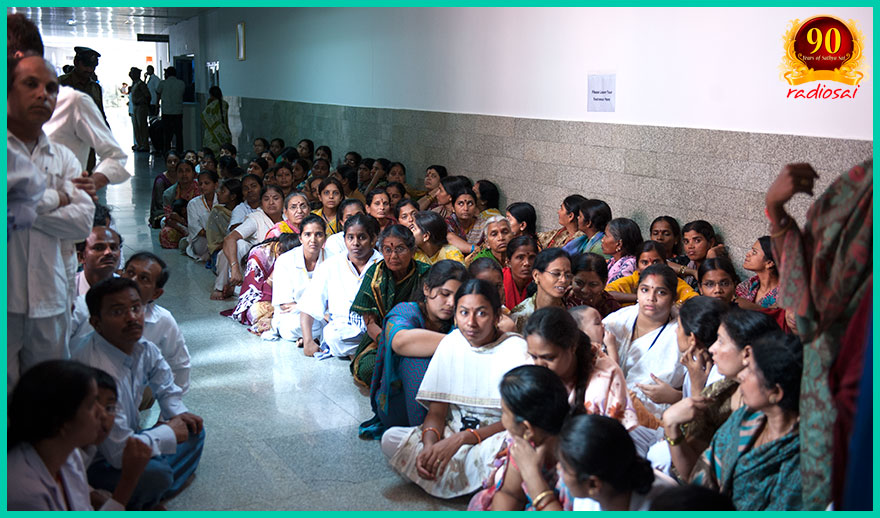 |
Sinceramente creí lo que dije porque a pesar de todas las señales mundanos, la idea de que Swami nos podía dejar era inaceptable."Al diablo con los señales", mi mente me decía; "Usted sabe Swami puede hacer cualquier cosa, cambiar el día en noche y la noche en día," y así sucesivamente. Así, cuando en la mañana del 24 de abril, la llamada telefónica del señor Giri, francamente, era una llamada que no estaba preparado para recibir, a pesar de los informes médicos de los últimos días anteriores eran todos apuntando de esa manera.
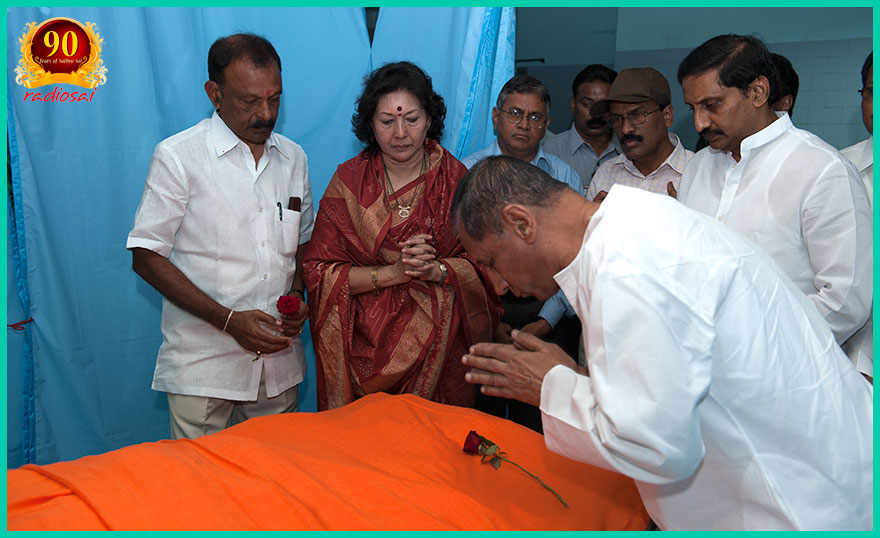 |
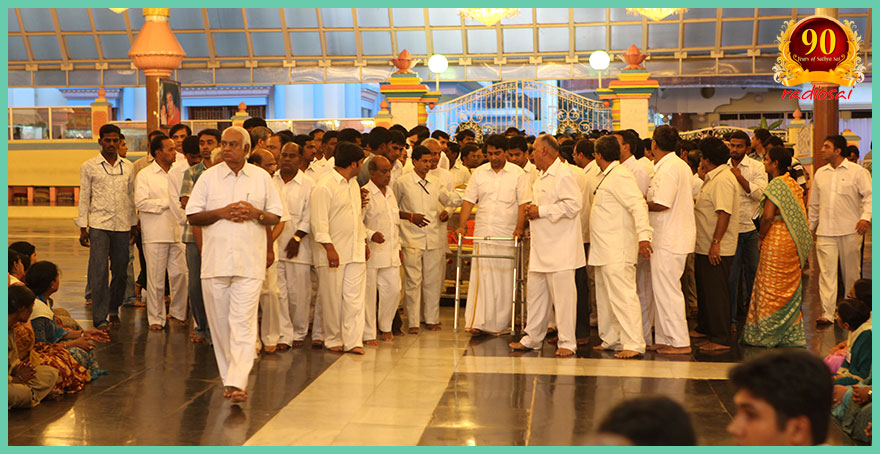 |
Yo no puedo recordar cómo me fui a través de los próximos tres días. De dos cosas sin embargo, estoy muy seguro. La primera fue que de repente, Radio Sai se aterrizó con el mayor empleo de medios de su historia. Por supuesto, los medios de comunicación públicos, que hasta el día anterior estaba cubriendo la historia de la hospitalización de Swami en gran medida desde el punto de hacer heno mediante la difusión de una gran cantidad de propaganda negativa de repente encontraron que Puttaparthi ahora se había convertido en el centro del mundo, en la medida de las noticias tan caliente era que se trate.
Había OB (transmisión al aire libre) furgonetas en todas partes. Cámaras piscina organizados por el Estado tuvo que ser colocado en el interior del Sai Kulwant Hall, y tuvimos que dar transmisiones en vivo de las cámaras de todo el mundo, aun cuando ambos devotos y personalidades desfilaron ante el 'cuerpo'. Venían de todas partes, los VVIPs, las personalidades, y las personas comunes también. El municipio estaba lleno y algunos de nuestros chicos fue a cubrir los eventos para la historia, sobre todo porque los medios de comunicación exterior estaba menos preocupado acerca de las personas para las que vinieron Swami.
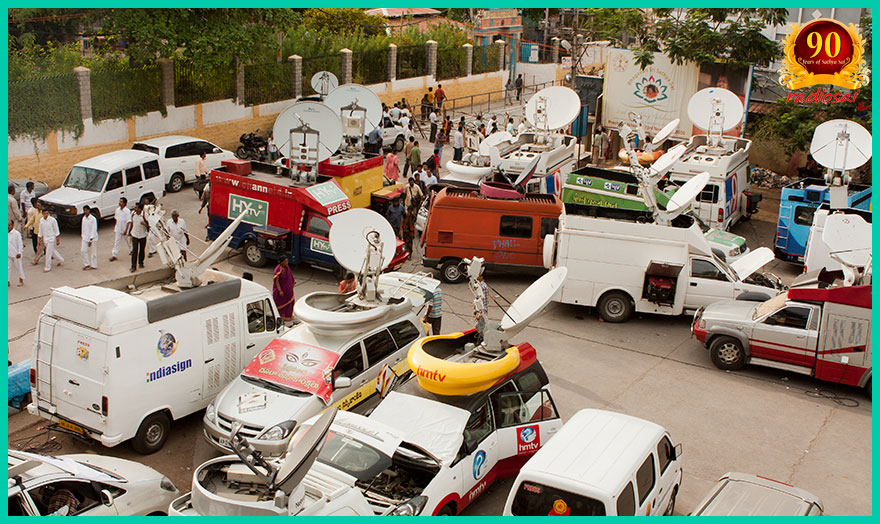 |
 |
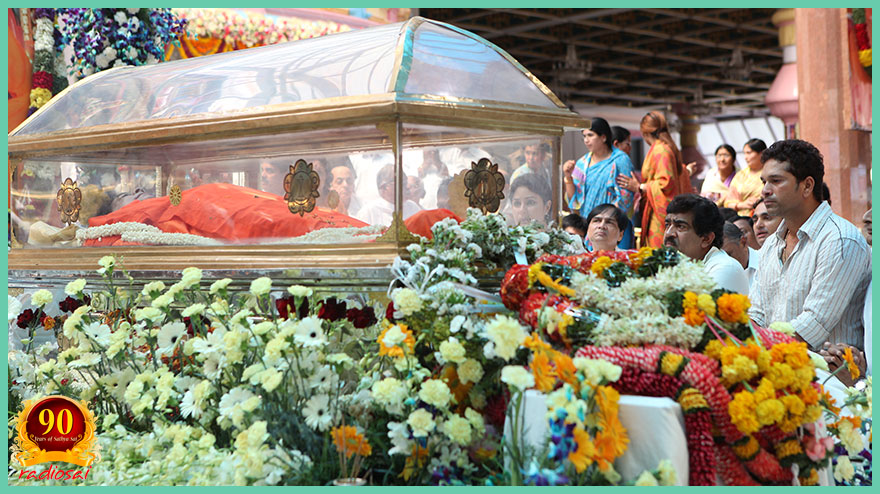 |
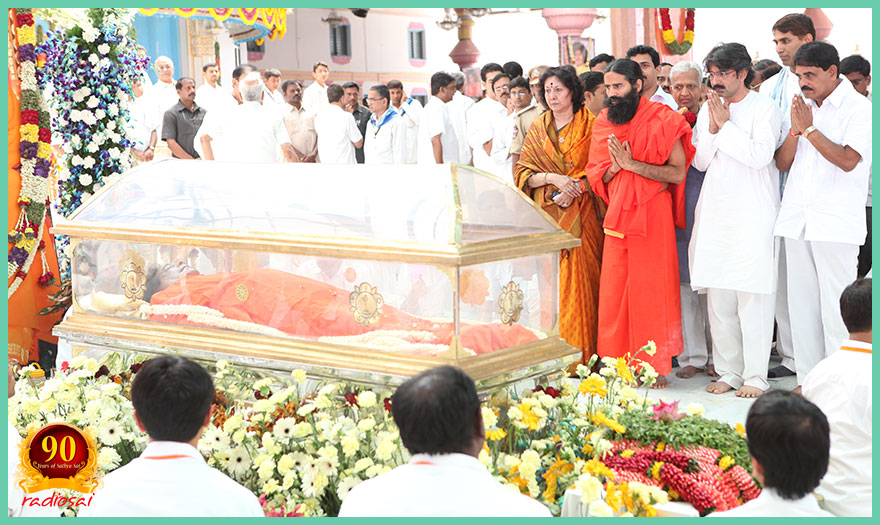 |
Mientras hablo, todas esas escenas van más allá de los ojos de mi mente como un borrón. Pero una cosa estaba seguro, ocupado, aunque todos nosotros estábamos, en el fondo había un peso en el corazón, hundido en un océano de dolor personal al que no podíamos dar expresión porque el trabajo tenía que continuar.
Llegó la última mañana, es decir, cuando los restos físicos debían ser internado. Las actuaciones tuvieron su propio impulso y el programa minuto a minuto mantienen sin descanso su tempo, con un fuerte nacional, así como un sabor multiconfesional añadido a la misma. Me senté a pesar de todo bastante aturdido, una parte de mí siempre alerta a los asuntos prácticos y otro lado retirado a un mundo diferente con sólo el Swami y yo, y un dolor profundo dentro de mí por la pérdida de la forma física.
Supongo que debe haber sido el caso de muchos en la sala como también el amplio mundo. La pregunta que seguía llegando una y otra vez fue: "¿Cómo diablos voy a hacer frente a esta terminación poderosa y convincente de contacto físico con Swami, a quien se podría convertir cualquier momento uno tenía un problema? " Incluso cuando estaba lidiando con mi propio sentimiento de pérdida que alguien me tiró de nuevo a la realidad por susurrando en mis oídos: "Ellos están buscando una Biblia.¿Sabes donde usted puede poner sus manos en uno? "Por un momento me asusté pero conseguir rápidamente el asimiento de mí mismo, respondió:" Hay uno en la estantería de mi despacho. Puede encontrar una copia de la Biblia allí. "Y luego de ser mi en constante práctica-yo, rápidamente agregó:" Úsalo, pero recuerde que debe poner de nuevo! "
Finalmente llegó el momento en que la forma física en realidad fue bajado a la fosa y, a partir de las VVIPs, las personas fueron escoltados a un lugar cerca de la fosa para que pudieran espolvorear un puñado de vibhuti en el hoyo. Algunas almas amables me escoltaron hasta el lugar, y mientras yo hice mi parte mi mente me decía, "Recuerde el número de veces que Él te dio vibhuti?Ahora que usted está ofreciendo vibhuti a Él, sólo por esta vez! Recuerde este momento y reflexionar sobre lo que significa para ti! "
 |
Era cerca del mediodía y la gente comenzó a irse. Como así lo hicimos, hubo anuncios informándonos que la rutina diaria sería regresar a su horario normal con Vedam cantando y cantando bhajans de la tarde.
Llegó la noche y la multitud se había reducido considerablemente. No eran sólo los de siempre, todos ellos reclamando sus asientos tradicionales, un privilegio que había sido suspendido sumariamente a partir del 24 de abril hasta el internamiento. Cuando Swami dio físicamente Darshan, evité el Veranda porque aunque protocolo sabia que tenía derecho a un asiento de primera en la primera fila, gracias a VIP apresuran requería cierta firmeza a la demanda y mantener el 'asiento'. Yo intensamente gustaba la idea de tener que reclamar mi asiento todos los días con un poco de litigante o el otro y preferí en vez de sentarse en mi antiguo lugar, es decir, en la terraza superior, cerca de la entrada principal de la Mandir adecuada. Había sólo un puñado de nosotros que prefiere sentarse en nuestro viejo lugar, y esto incluye el Sr. Chakravarthi.
 |
En este día de la llamada vuelta a la normalidad cuando Swami comenzaría Su Samadhi Darshan fui a la terraza y con angustia vi un montón de flores donde Swami normalmente sentarse o hablar de. Tantos pensamientos vinieron corriendo hacia atrás. Ahogando ellos como también con lágrimas en mis ojos, volví a mi guarida habitual, para sentarse a través Vedam cantar y bhajans. Esto se prolongó durante algunos días hasta que un día toda la zona de terraza fue cerrada y cerrada para la construcción del Samadhi.
El Guru Purnima día de 2011, el Samadhi como ahora hemos fue abierto al público, y el diario, así como las rutinas especiales volvió al formato de los días en que Swami se sentaba físicamente en la terraza inferior. Algunas cosas han cambiado en la era post-Mahasamadhi, necesariamente, mientras que otros no tienen, por razones obvias.
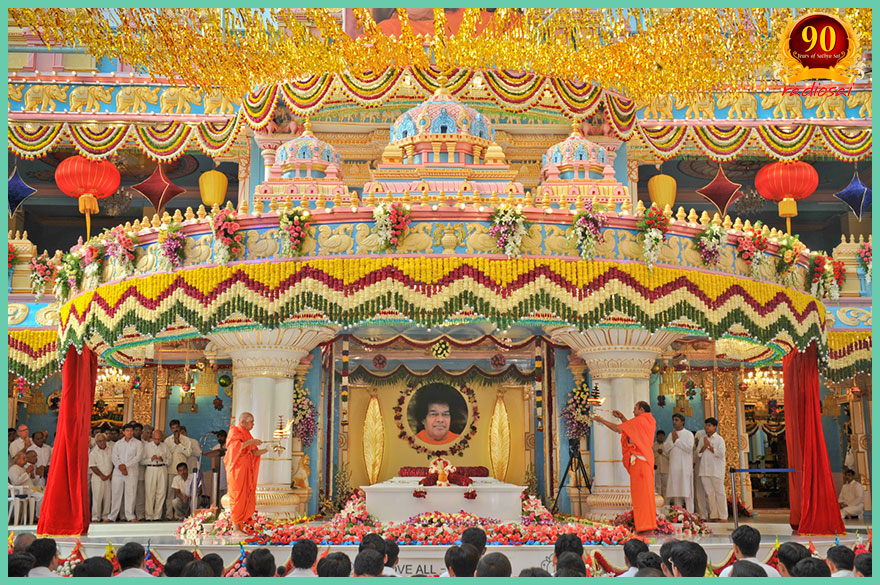 |
|
La hercúlea tarea de manejar la Transición
Por lo tanto, qué tan fácil o áspera fue la transición a la "era post-Forma Física"? En otras palabras, ¿cómo Prashanti Nilayam (que significa realmente el Fideicomiso Central) hacer la transición y ¿qué ha estado haciendo desde entonces para mantener el vuelo de la bandera, voy a decir? Creo que yo evoco, se necesitan unas pocas palabras sobre este tema.
Para empezar, todos nosotros esperaba y rezaba que Swami dejaría con sólo darnos un susto terrible, no nos dejan, pero que no iba a ser. Como Swami mismo ha declarado muchas veces, "Dios no consulta a nadie acerca de cuando y donde Él encarnar.Tampoco hacen ampliamente conocido que El escogería como Sus padres corporales, el momento de la encarnación, etc. "Swami hizo también muy claro que la misma libertad está disponible a Él como cuando Él se caiga el telón. Dicho esto, queda claro que la retirada de Swami no vino como una sorpresa.
A partir de los boletines diarios que fueron cada vez más siniestra, estaba claro que el final se acercaba. Pero cuando la retirada sucedió realmente, había una sensación generalizada de una descarga profunda, porque nos golpeó todo lo que ninguno de nosotros podía correr a Swami para el consejo. Además, el Mahasamadhi significó que durante la noche, el mundo estaría centrado en Puttaparthi / Prashanti Nilayam para los próximos varios días y, cualquiera que sea la gente podría decir, que de hecho ha resultado ser de esa manera.
Volviendo al caso Mahasamadhi, la manipulación de las grandes multitudes y la preservación del orden era una tarea enorme en sí mismo. Luego estaba la Media, medios de comunicación globales como resultó. A esto se añade la carga adicional de VIPs y VVIPs de todos los géneros y el propio Primer Ministro a aparecer de repente; Debo decir que por la Gracia de Swami, las cosas se fueron sin problemas.
Sabes algo? Cuando el entonces primer ministro, el Dr. Manmohan Singh, y la señora Sonia Gandhi llegó a ofrecer sus respetos, se sentaron en el suelo al igual que todos nosotros lo hizo. Se sentaron en una silla por un momento sólo para firmar el libro de condolencias - eso es todo.
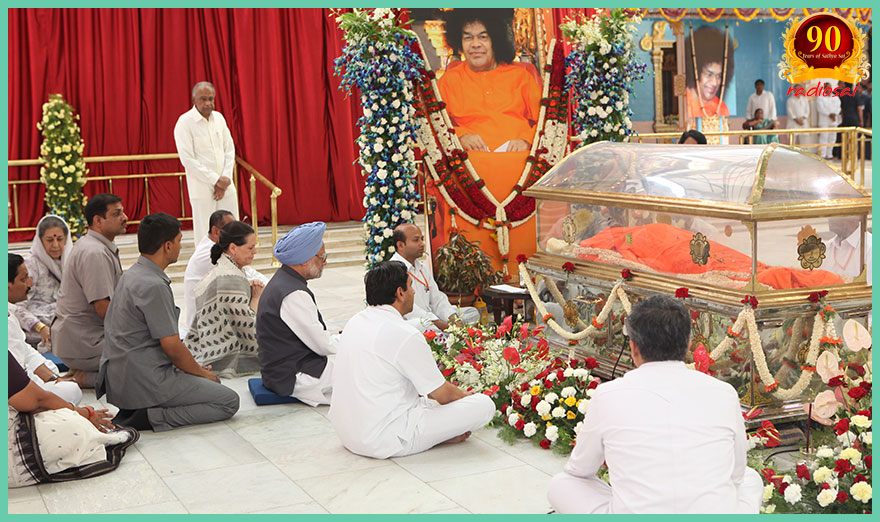 |
Después del evento Mahasamadhi había terminado, ahora era el turno de los medios de comunicación locales para tener su día por tratar de "enfrentar" a los miembros del Fideicomiso. Los miembros de la Fundación eran más paciente. Se abordaron varias ruedas de prensa - sé porque nuestros chicos grabaron todos ellos - y, finalmente, ese zumbido se calmó. Las secciones de la prensa extranjera esa conferencia sin cesar en la precisión, la objetividad, la libertad de prejuicios, etc., tuvieron su día, con un poco de ser crudamente impetuoso en sus obituarios, mientras que otros trataron de actuar "justo", lo que significa que ellos dieron la misma importancia a la Swami ya los que estaban en contra de él - así es como lo hace los medios de comunicación un acto de equilibrio.
Hace muchos años que tenía, aquí en Prashanti, una larga conversación con un productor documental canadiense que estaba genuinamente interesado en hacer un buen documental sobre Swami. Yo le pregunté: "¿En su documental, ¿le dará tiempo para aquellos que expresan puntos de vista negativos sobre Swami?" Su respuesta fue: "Yo no quiero, pero nuestro código medios me exige." Yo respondí: "Supongamos que hiciste una película sobre Jesús? ¿Qué haría usted en ese caso? "
Su respuesta me sorprendió; él dijo: "Yo tendría que dar tiempo a puntos de vista anti-Jesús! Esa es la forma en que el mundo se encuentra actualmente. Todo lo que puedo controlar es la relación. Mi documental más favorable tendría una relación de 60/40, es decir el 60% sería positivo mientras que el 40% del tiempo haría que debe darse a la parte negativa. "Dio la casualidad de que algunos años más tarde, muchos documentales producidos que eran 100% contra Swami; parecía como si la llamada "justicia razonable" ya había dado paso a un total de injusticia y salido con la suya.
Me tomó algunos años para entender que los actores negativos son una parte del drama divino. De hecho he oído Swami decir que es actores negativos que permiten devotos a apreciar su gloria mejor! Menciono todo esto porque había un montón de tonterías escritas y dijo en ese momento Mahasamadhi. Afortunadamente, el flujo incesante de Tiempo desde ha barrido todo eso muck distancia.
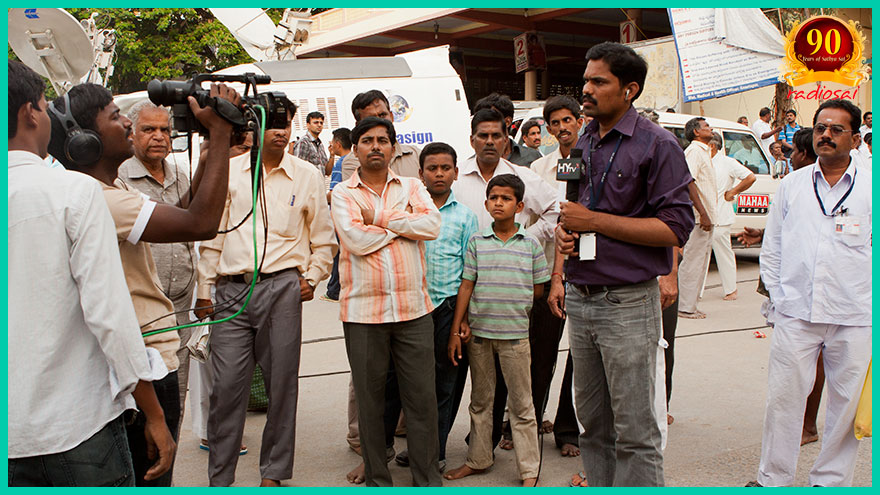 |
La confianza y el Ashram - vibrante como siempre
En los años que han seguido, los fiduciarios que también resultan ser residentes permanentes del Ashram han hecho tres contribuciones importantes. En primer lugar, han logrado estabilizar el funcionamiento del Ashram, en una nueva era post-Mahasamadhi.En segundo lugar, se han empezado a mejorar algunos de los servicios y comodidades. Por ejemplo, las carreteras, aunque lejos de ser perfecto, están en una forma mucho mejor que antes. También hay muchos tableros de la muestra, que carecíamos aún a tiempo Mahasamadhi. Y, más que cualquier otra cosa, el lugar es un verde mucho. Lo sé porque me voy a pasear todas las noches. Estoy totalmente de acuerdo en que aún queda mucho por hacer, pero luego estar seguro de que a partir de ahora el ritmo de mejora se reunían ritmo.
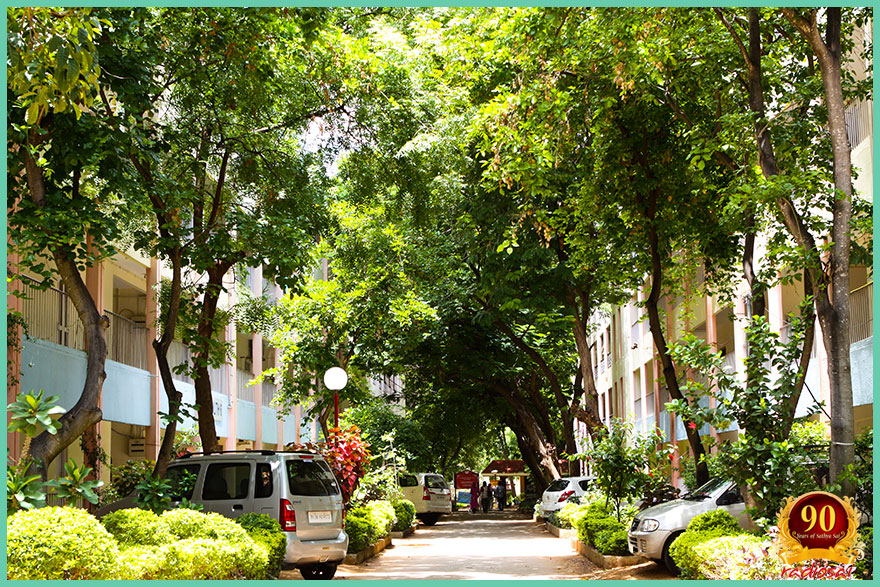 |
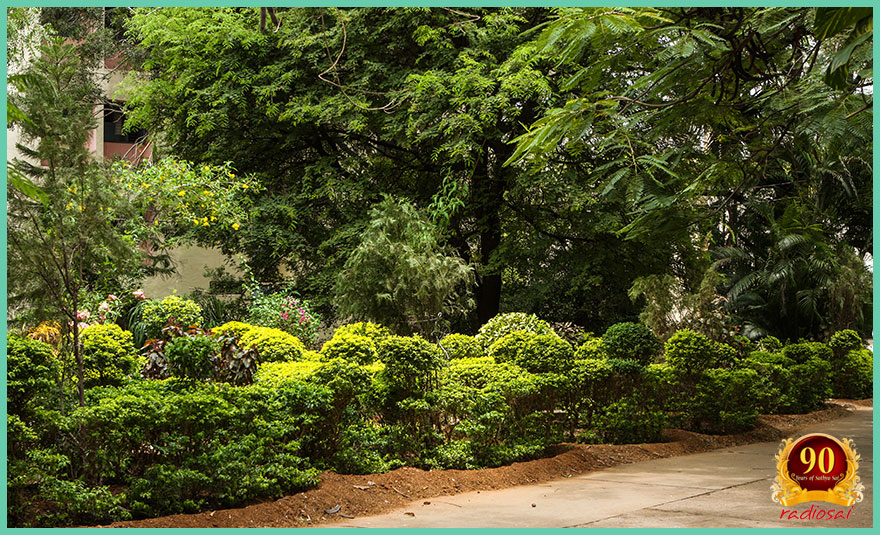 |
Y, si se me permite volar nuestra propia trompeta, es decir, el de Radio Sai, puedo decir que ha adelantado enormemente, sobre todo en la parte frontal de vídeo. De repente, la demanda de nuestra experiencia se ha disparado. Sólo para dar un ejemplo reciente, en un día en particular, nuestros muchachos tenían que cubrir una función aquí en el Sai Kulwant Hall, cubrir el Ati Rudra Maha Yagnam pasando en Brindavan, y también ayudar con la cobertura de vídeo de una función en el Hospital de Super Aquí! Me refiero a nuestros muchachos tenían que dar cobertura a tres funciones en un solo día - es decir cuánto ha aumentado nuestra carga!
Mi punto es que hay un nuevo tempo que ha comenzado la construcción de, impulsado en parte por la rápida aproximación del 90mo cumpleaños. Voy a arreglar para un artículo complementario que se publicará en nuestro sitio web en el que no sólo daremos todos los detalles de lo que Radio Sai ha estado haciendo en el período post-Mahasamadhi sino también lo que planeamos hacer durante la década para el Centenario, es decir, el cumpleaños número 100 en 2025.
El Edificio Magnífico conservar su Mensaje para la Eternidad
Y por cierto; Casi se me olvidó mencionar el archivo. Durante la década, Radio Sai ha estado recogiendo en silencio audio cintas, fotos, manuscritos escritos a mano, cartas, cintas de vídeo y películas (tanto 8 mm y 16 mm) relacionados con Swami y sus varios viajes. De hecho, un nuevo edificio se acerca a la casa de todos estos preciosos originales. Fotos de la construcción, junto con un buen relato aparecerían como una parte del artículo compañera prometido antes. El artículo también incluiría dos imágenes satelitales de Puttaparthi y la zona de Ashram, uno adoptadas en 2003, y una imagen más reciente tomada en 2012 y con una resolución más alta.Al comparar estos dos, se puede ver que la cantidad más verde del Ashram se ha convertido durante una década. Si quieres una prueba más, tomar un buen paseo y usted sabe!
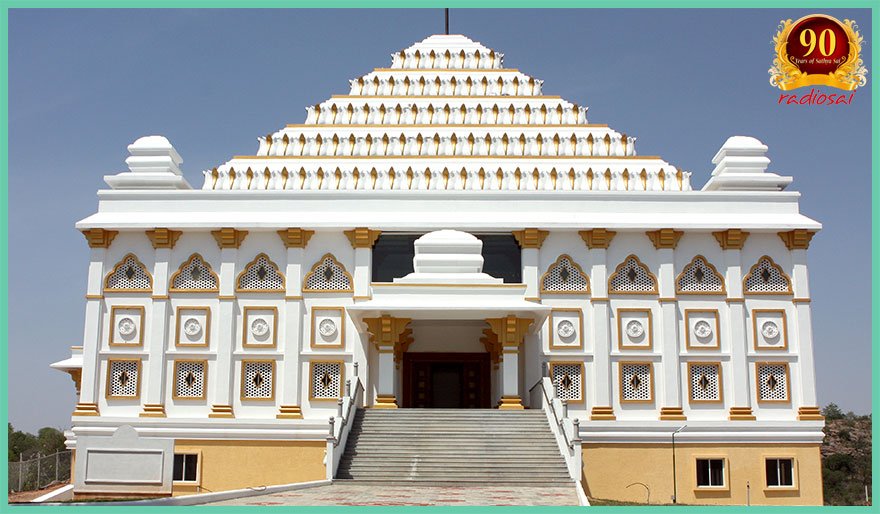 |
| Este edificio, una vez inaugurada albergará y preservar de la manera más científica de todas Bhagavan literatura, voz y video en su forma original |
Hay muchas cosas que me gustaría decir, pero en la actualidad, no tengo tiempo suficiente para ello. Aquellos de ustedes, que en sintonía con la función especial que tuvo lugar esta mañana, no habría perdido la inauguración de la presentación reverencial del Sai Pancharathna Kirthanas. Esta oferta musical se está haciendo en el mismo espíritu que la observancia del Día Tyagaraja Aradhana que, por cierto, celebró su 168o aniversario este año. Eso significa que la observancia de la Tyagaraja Aradhana se remonta hasta el final a 1847, cuando la East India Company gobernó la India, la guerra civil americana fue hasta una década o así, y James Clerk Maxwell era todavía de escribir su famosa teoría electromagnética de la radiación, gracias a la cual ahora tenemos radio, TV y comunicaciones por satélite!
Aradhana Prashanti Nilayam en Mahothsavam (Programa de la mañana) - 24 de abril 2015
Lo que estoy tratando de decir es que en los próximos años, espero que la adoración de Dios a través de la música reverencial que siempre ha sido una gran tradición en este país, Naadopasanaa como se le conoce, viviría como lo haría el canto de Sai Pancharathna en Sri Sathya Sai Día Aaradhana, de hecho, en todas las partes del mundo donde la música carnática es popular. Si Tyagaraja Aaradhana se celebra en el fervor de todo el camino de Cleveland, EE.UU. a Melbourne, Australia por el canto de Tyaragaja Pancharathna krithis, entonces por qué no el canto de Sai Pancharathnas también?
Pensar en ello!
Dios los bendiga, y Jai Sai Ram.
- Radio Equipo Sai
TRADUCIDO EN INTERNET
THIS DAY THAT YEAR
Prof. G. Venkataraman
Loving Sai Ram and greetings from Prasanthi Nilayam. Today is Sri Sathya Sai Aradhana Day. Inevitably, my thoughts go back to this same date but four years ago, as must be the case with most of you.
The Traumatic Memories of April 2011
It was around 7:30 in the morning of April 24 2011, I received a phone call from a good friend of mine who was in the Hospital. In a frantic voice he kept on whispering, "Swami's condition is very serious, very serious." He then cut off the call. Frankly, this was a news I was not expecting and there is a reason why, which I shall come to shortly. But to get on with the events of the morning, around 7:50 AM, I got a call, once again from the Hospital. This time it was Mr. Giri on the line who gravely said, "Sai Ram Sir. I am very sorry to inform you that our beloved Swami passed away a couple of minutes ago. Mr. Chakravarthi is standing next to me, and he wants to say something."
Next moment, Mr. Chakravarthi came on the line and said, "Doc – that was how he always addressed me – doc, please prepare an obituary note." I asked in what style should it be. Since he was not prepared for that question, I cut in and said, "Do you want it done like what appears in say The Times of London?" "Yes," Mr. Chakravarthi came back, and added, "it could be around 300 words. We want to release it to the press." Immediately I got to work. The body worked like a machine while the mind was elsewhere, pretending that what had just happened was all a dream; in any case I was sort of numb to feel any ache.
 |
Inevitably my mind went to the events of the previous evening. As was our daily routine, Prof. Pandit and I went straight to Dr. Safaya's office. For those who do not know, Prof. Vishwanath Pandit is a distinguished economist, one who has taught in Swami's Institute since 1985, and also served as the eighth Vice Chancellor. Going back to what I was saying, Dr. Safaya was the Director, a post he was holding from before the inauguration of the Hospital on November 22, 1991. Like Prof. Pandit, Dr. Safaya also was originally from Kashmir, and they were old friends. At the time we went, Dr. Safaya was finalizing the daily medical bulletin for release to the press. Every day before we left, Dr. Safaya would invariably give me a copy of that day's Medical Bulletin on Swami, for use by Radio Sai. In between, the discussion would always be about Swami's health and His condition at that particular time.
I remember that about two days or so after He was admitted, Swami required the insertion of what is called a balloon pump which made the heart's job of pumping a lot easier. It was about 7 PM that day, and an hour earlier, two doctors who had specially flown in from Bangalore by helicopter left, their job done. Thanks to Dr. Safaya, both Prof. Pandit and I were able to catch a quick glimpse of Swami as He was wheeled in on a movable special bed to the special ICU meant for Him. Dr. Safaya went inside along with Swami and the doctors, while Prof. Pandit and I sat on the chairs placed outside for folks like us.
 |
I then said to Dr. Safaya, "Doctorsaab, you may remember that a high-power Committee is scheduled to visit the Hospital for discussions with you and some of the scientists of Swami's Institute, regarding a medical instrumentation project. That visit is due on April 6th which is not far away. Given that Swami is in the Hospital, maybe we should ask the Committee to postpone its visit for the time being. What do you say?" Looking very confident, Dr. Safaya replied, "Don't worry. Swami would be fine and in fact, I shall host a lunch for the Committee."
Sadly, that was not to be since Swami's health refused to get better; on the other hand, it went into a slow decline due to multi-organ failure. About fifteen days or so after admission when I was in Dr. Safaya's office, along with Prof. Pandit of course, I asked, "Doctorsaab, this multi-organ failure – for how many days does it last?" Before Dr. Safaya could answer, someone else who was in the room butted in to say, "I will answer that question for I happen to know about multi-organ failure. It happened to my daughter-in-law, and it took just five days." I then said, "It looks like Swami is deliberately stretching this out to test us. In the end, I am sure He would bounce back leaving us all stunned!"
I am mentioning all this because I want to get back to the evening before Mahasamadhi, i.e., April 23, 2011. Soon after we entered the Director's room and asked the regular question, "How is Swami today?", Dr. Safaya responded, "You know, something very interesting happened this morning. As usual I visited Swami in the ICU, talked to the boys and doctors attending on Him, and then went on my regular rounds. Around 1 PM I was back in my office and getting ready to go home for lunch. Just then I received a call to come immediately to the ICU. I was scared and rushed back to the ICU. Guess what? Swami was wide awake and whispering words. He looked at me, recognised me and nodded. I was so happy."
When I heard this, I was happy too and said in response, "You know what? Swami is going to get well in a few days after throwing a huge scare into all of us. He would then look squarely at us and mockingly ask: "Did you fellows imagine I would go away without straightening out all of you?"
 |
I honestly believed what I said because despite all the worldly signals, the idea that Swami could leave us was just unacceptable. "Damn the signals", my mind kept telling me; "you know Swami can do anything, change day into night and night into day," and so on. Thus, when on the morning of April 24, the phone call came from Mr. Giri, frankly, it was a call I was not ready to receive, though the medical reports of the last few earlier days were all pointing that way.
 |
 |
I can't quite remember how I went through the next three days. Of two things though, I am quite sure. The first was that suddenly, Radio Sai was landed with the biggest media job of its history. Of course, the public media which till the previous day was covering the story of Swami's hospitalisation largely from the point of making hay by broadcasting a lot of negative propaganda suddenly found that Puttaparthi had now become the centre of the world as far as hot news was concerned.
There were OB (outdoor broadcast) vans everywhere. Pool cameras organised by the State had to be positioned inside the Sai Kulwant Hall, and we had to give live feeds from those cameras to the entire world, even as both devotees and VIPs filed past the 'body'. They came from everywhere, the VVIPs, the VIPs, and the ordinary folks as well. The township was crowded and some of our boys went to cover those events for history, especially because the outside media was least bothered about the people for whom came Swami.
 |
 |
 |
 |
As I speak, all those scenes are going past my mind's eye like a blur. But one thing was sure, busy though all of us were, deep inside there was a heavy heart, sunk in an ocean of personal grief to which we could not give expression because work had to go on.
Came the last morning, i.e., when the physical remains were to be interned. The proceedings had its own momentum and the minute-by-minute program relentlessly maintained its tempo, with a strong national as well as a multi-faith flavour added to it. I sat through it all quite dazed, one side of me ever alert to practical matters and another side withdrawn into a different world with only Swami and me, and a deep ache within me about the loss of the physical form.
I suppose that must have been the case with many in the hall as also the wide world over. The question that kept coming up again and again was: "How on earth am I going to cope with this powerful and compelling termination of physical contact with Swami, to whom one could turn any time one had a problem?" Even as I was grappling with my own sense of loss someone yanked me back to reality by whispering into my ears, "They are looking for a Bible. Do you know where you can lay your hands on one?" For a moment I was startled but quickly getting hold of myself, replied, "There is one in the bookshelf of my office. You can find a copy of the Bible there." And then being my ever- practical-self, quickly added, "Use it, but remember to put it back!"
Finally came the moment when the physical form was actually lowered into the pit and, starting with the VVIPs, people were escorted to a place near the pit so that they could sprinkle a handful of vibhuti into the pit. Some kind souls escorted me to the spot, and while I did my bit my mind was telling me, "Remember the number of times He gave you vibhuthi? Now you are offering vibhuthi to Him, just this one time! Remember this moment and reflect on what it means to you!"
 |
It was about noon and people began to leave. As we did so, there were announcements informing us that the daily routine would return to its normal schedule with Vedam chanting and Bhajan singing in the evening.
Evening came and the crowd had considerably thinned. There were just the usual people, all of them claiming their traditional seating, a privilege that had been summarily suspended from April 24 until internment. When Swami physically gave Darshan, I avoided the Veranda because although protocol-wise I was entitled to a prime seat in the front row, thanks to VIP rush it required some assertiveness to demand and retain the 'seat'. I intensely disliked the idea of having to claim my seat everyday with some litigant or the other and preferred instead to sit in my old place, i.e., on the upper veranda, close to the main entrance to the Mandir proper. There were just a handful of us who preferred to sit in our old place, and this included Mr. Chakravarthi.
 |
On this day of so-called return to normalcy when Swami would commence His Samadhi Darshan I went down to the veranda and with anguish saw a mound of flowers where Swami would normally sit or speak from. So many thoughts came rushing back. Stifling them as also tears welling in my eyes, I returned to my usual haunt, to sit through Vedam chanting and Bhajans. This went on for some days till one day the entire veranda area was shuttered up and closed for the construction of the Samadhi.
On Guru Poornima Day 2011, the Samadhi as we now have was opened to the public, and the daily as well as the special routines went back to the format of the days when Swami would physically sit in the lower veranda. Some things have changed in the post-Mahasamadhi era, necessarily so, while others have not, for obvious reasons.
 |
|
The Herculean Task of Handling the Transition
So, how easy or rough was the transition to the "post-Physical Form era"? In other words how did Prasanthi Nilayam (meaning really the Central Trust) make the transition and what has it been doing since then to keep the flag flying, shall I say? I think as I reminisce, a few words on this subject are needed.
To start with, all of us hoped and prayed that Swami would stop with just giving us a terrific scare, not leave us but that was not to be. As Swami Himself has declared many times, "God does not consult anyone about when and where He would incarnate. Nor does He make known widely whom He would choose as His bodily parents, the time of incarnation, etc." Swami also made it very clear that the same freedom is available to Him as to when He would bring the curtain down. That being said, it is clear that Swami's withdrawal did not come as a surprise.
From the daily bulletins which were becoming increasingly ominous, it was clear that the end was nearing. But when the withdrawal actually happened, there was a widespread sense of deep shock, for it hit us all that none of us could now run to Swami for advice. Furthermore, the Mahasamadhi meant that overnight, the world would be focussed on Puttaparthi/Prasanthi Nilayam for next several days and, whatever people might say, it indeed has turned out to be that way.
Getting back to the Mahasamadhi event, handling the large crowds and preserving order was a huge task in itself. Then there was the Media, global media as it turned out. Add to that the additional burden of VIPs and VVIPs of all genres and the Prime Minister himself showing up suddenly; I must say that by Swami's Grace, things went off smoothly.
You know something? When the then Prime Minister Dr. Manmohan Singh and Mrs. Sonia Gandhi came to offer their respects, they sat on the ground just like all of us did. They sat momentarily on a chair only to sign the condolence book – that is all.
 |
After the Mahasamadhi event was over, it was now the turn of the local media to have its day by trying to "confront" the Trust Members. The Members of the Trust were most patient. They addressed several Press Conferences – I know because our boys taped all of them – and finally that buzz died down. Sections of the foreign press that lecture endlessly on accuracy, objectivity, freedom from bias, etc., had their day, with some being crudely brash in their obituary notices, while others tried to act "fair", meaning that they gave equal prominence to Swami and to those who were against Him – this is how the Media does a balancing act.
Many years ago I had, here in Prasanthi, a long conversation with a Canadian Documentary producer who was genuinely interested in making a nice documentary on Swami. I asked him, "In your documentary, would you give time for those who express negative views on Swami?" His reply was, "I don't wish to but our media code requires me to." I countered, "Suppose you did a film on Jesus? What would you do in that case?"
His answer surprised me; he said, "I would have to give time to anti-Jesus views! That is the way the world is presently. All I can control is the ratio. My most favourable documentary would have a 60/40 ratio, that is to say 60% would be positive while 40% of the time would to be given to the negative side." It so happened that some years later, many produced documentaries that were 100% against Swami; it seemed as if so-called "reasonable fairness" had now given way to total unfairness and got away with it.
It took me some years to understand that negative actors are a part of the Divine Drama. In fact I have heard Swami say that it is negative actors who enable devotees to appreciate His Glory better! I am mentioning all this because there was a lot of nonsense written and said at the Mahasamadhi time. Mercifully, the relentless flow of Time has since swept all that muck away.
 |
The Trust and Ashram - Vibrant as Ever
In the years that have followed, the Trustees who also happen to be permanent residents of the Ashram have made three major contributions. First, they have managed to stabilize the functioning of the Ashram, in a new post-Mahasamadhi era. Secondly, they have started improving some of the facilities and conveniences. For example, the roads, though far from perfect, are in a much better shape than before. There are also many sign boards, which we lacked even at Mahasamadhi time. And, more than anything else, the place is a lot greener. I know this because I go for a walk every night. I completely agree that a lot remains to be done but then be assured that from now on the pace of improvement would gather pace.
 |
 |
And, if I may blow our own trumpet, i.e., that of Radio Sai, I can say it has leapfrogged enormously, especially on the video front. All of a sudden, the demand for our expertise has sky-rocketed. Just to give an example recently, on one particular day, our boys had to cover a function here in the Sai Kulwant Hall, cover the Athi Rudra Maha Yagnam going on in Brindavan, and also help with video coverage of a function in the Super Hospital here! I mean our boys had to provide coverage for three functions in one day – that is how much our load has increased!
My point is that there is a new tempo that has started building up, boosted in part by the rapid approach of the 90th Birthday. I shall arrange for a companion article to be published on our website where we shall not only give full details of what Radio Sai has been doing in the post-Mahasamadhi period but also what we plan to do during the decade to the Centenary, i.e., the 100th Birthday in 2025.
The Magnificent Edifice to Preserve His Message for Eternity
And by the way; I almost forgot to mention the archive. Over the decade, Radio Sai has been quietly collecting audio tapes, photos, hand written manuscripts, letters, video tapes and films (both 8 mm and 16 mm) related to Swami and His various trips. In fact a new building is coming up to house all these precious originals. Pictures of the building, along with a good write-up would appear as a part of the companion article promised earlier. The article would also include two satellite pictures of Puttaparthi and the Ashram area, one taken in 2003, and a more recent picture taken in 2012 and at a higher resolution. By comparing these two, you can see that how much greener the Ashram has become during a decade. If you want further proof, take a good walk and you would know!
 |
| This building once inaugurated will house and preserve in the most scientific manner all of Bhagawan's literature, voice and video in its original form |
There are many things I would like to say but presently, I do not have time enough for it. Those of you, who tuned in to the special function held this morning, would not have missed the inauguration of the reverential presentation of the Sai Pancharathna Kirthanas. This musical offering is being made in the same spirit as the observance of Tyagaraja Aradhana Day which, by the way, celebrated its 168th anniversary this year. That means that the observance of the Tyagaraja Aradhana goes back all the way to 1847, when the East India Company ruled India, the American Civil War was till a decade or so away, and James Clerk Maxwell was still to write down his famous electromagnetic theory of radiation, thanks to which we now have radio, TV and satellite communication!
Aradhana Mahothsavam at Prasanthi Nilayam (Morning Programme) - 24 Apr 2015
What I am trying to say is that in the years to come, I do hope that worship of God through reverential music which has always been a great tradition in this country, Naadopasanaa as it is known, would live as would the singing of Sai Pancharathna on Sri Sathya Sai Aaradhana Day, indeed in all parts of the world where Carnatic music is popular. If Tyagaraja Aaradhana is celebrated in fervour all the way from Cleveland, USA to Melbourne, Australia by the singing of Tyaragaja Pancharathna Krithis, then why not the singing of Sai Pancharathnas also?
Think about it!
God bless, and Jai Sai Ram.
- Radio Sai Team
FUENTE:
http://media.radiosai.org/journals/vol_13/01APR15/musings-by-g.venkataraman.htm






















No hay comentarios :
Publicar un comentario